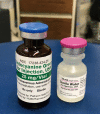Fluorescence techniques in adrenal surgery
- PMID: 31404180
- PMCID: PMC6646814
- DOI: 10.21037/gs.2019.03.01
Fluorescence techniques in adrenal surgery
Abstract
This chapter describes the use of fluorescence via indocyanine green (ICG) in minimally invasive adrenal surgery (laparoscopic and robotic). ICG is a non-toxic dye that can aid identification of vascular structures and parenchymal tissue planes in real time. The primary utility of ICG fluorescence in adrenal surgery is to help delineate the margins of resection, to guide a more precise operation. In particular, for patients with bilateral adrenal disease or a heredity associated with high risk of recurrence (e.g., VHL, MEN2a) this may facilitate subtotal adrenal resection (e.g., cortical sparing adrenalectomy), obviating the incidence of iatrogenic adrenal insufficiency and its numerous sequelae including lifelong hormone supplementation, osteoporosis and risk of Addisonian crisis.
Keywords: Adrenal surgery; fluorescence angiography; indocyanine green (ICG); laparoscopy; near infrared imaging (NIR imaging).
Conflict of interest statement
Conflicts of Interest: The authors have no conflicts of interest to declare.
Figures






References
Publication types
LinkOut - more resources
Full Text Sources
Miscellaneous
